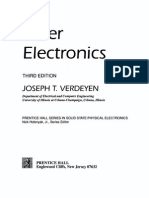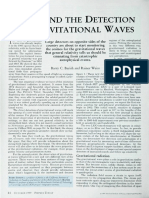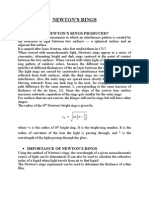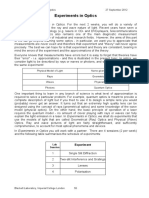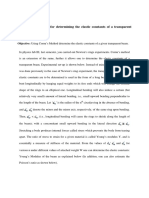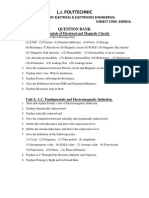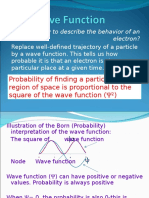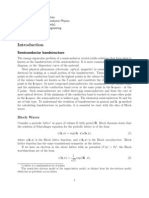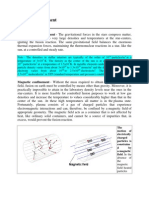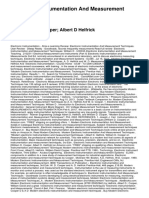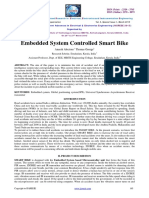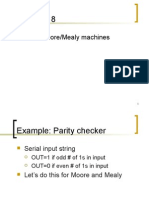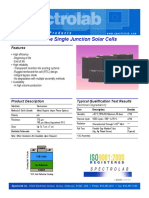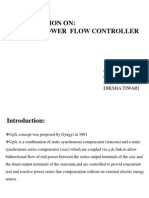W07 L4 Diodes
W07 L4 Diodes
Uploaded by
Manjot KaurCopyright:
Available Formats
W07 L4 Diodes
W07 L4 Diodes
Uploaded by
Manjot KaurOriginal Description:
Copyright
Available Formats
Share this document
Did you find this document useful?
Is this content inappropriate?
Copyright:
Available Formats
W07 L4 Diodes
W07 L4 Diodes
Uploaded by
Manjot KaurCopyright:
Available Formats
Diodes and
Diode Circuits
Slides taken from:
A.R. Hambley, Electronics, Prentice Hall, 2/e, 2000
A. Sedra and K.C. Smith, Microelectronic Circuits,
Oxford University Press, 4/e, 1999
Semiconductor Diode
Figure3.1Semiconductordiode.
2
The diode equation (1)
For forward and reverse bias region:
The diode equation (2)
Zooming in the v-i characteristic
Figure 3.2 Volt-ampere characteristic for a typical small-signal silicon diode at a
temperature of 300 K. Notice the changes of scale.
Forward Region
Reverse Region
Forward & Reverse regions (1)
Forward & Reverse regions (2)
Breakdown region
The breakdown region is entered when the magnitude of
the reverse voltage exceed a threshold called
breakdown voltage or the zener knee voltage.
In the breakdown region the current increase rapidly with
a very small increase in the associated voltage.
There is an avalanche of electrons flowing across the
junction with the result that the diode overheat.
Provided that the power dissipated in the diode is limited
by external circuitry to a safe level (typically specified in
the data sheets) breakdown wont be destructive.
10
Ideal diode approximation
Figure 3.8 Ideal-diode volt--ampere characteristic.
11
Improved approximated diode model
12
Half-wave rectifier
Fig. 3.3 (a) Rectifier circuit. (b) Input waveform. (c) Equivalent circuit when
(d) Equivalent circuit when v1 0 (e) Output waveform.
13
Half-wave rectifier with
smoothing capacitor
Fig. 3.41 Voltage and current waveforms in the peak rectifier circuit with CR T.
The diode is assumed ideal.
14
Full-wave rectifier
15
Figure 3.13 Full-wave rectifier.
Full-wave bridge rectifier
Figure 3.14 Diode-bridge full-wave rectifier.
16
Full-wave bridge rectifier
Fig. 3.39 The bridge rectifier: (a) circuit and (b) input and output waveforms.
17
Limiters (=Clipping circuits) (1)
18
Limiters (=Clipping circuits) (2)
19
Clamping circuits (1)
20
Clamping circuits (2)
21
Clamping circuits (3)
22
More clamping circuits (1)
23
More clamping circuits (2)
24
More clamping circuits (3)
Figure 3.19 Another Example of clamp circuit.
25
Voltage doubler (1)
26
Voltage doubler (2)
27
Voltage doubler (3)
28
Diode small signal model
So
far we have been mainly focused on using
the ON-OFF behavior of the diode. In these
applications usually the applied signal is
relatively large so the models seen so far are
more than adequate !
There are other applications where the diode
is biased to operate at a certain point (VDQ, IDQ)
on the i-v characteristic and a small AC signal
is superimposed on the DC quantities
29
The Load Line Analysis
Figure 3.27 Analysis of a circuit containing a singular nonlinear element can be accomplished by
load-line analysis of a simplified circuit.
30
The device operating point
(= bias point = Q-point)
Figure 3.4 Circuit for load-line analysis.
31
The load-line concept
Figure 3.5 Load-line analysis of the circuit
of Figure 3.4.
32
The device Q-point (quiescent)
Figure 3.31 Diode characteristic, illustrating the Q-point.
33
The device small signal model
Fig. 3.25 Development of the diode small-signal model.
Note that the numerical values shown are for a diode
with = 2.
34
Diode small signal model
35
Diode small signal model
36
Diode small signal model
37
Diode small signal model
38
Diode small signal model
39
Example of small signal application
Figure 3.33 Variable attenuator using a diode as a controlled resistance.
40
DC equivalent circuit
Figure 3.34 Dc circuit equivalent to Figure 3.33 for Q-point analysis.
41
Small signal AC equivalent circuit
Figure 3.35 Small-signal ac equivalent circuit for Figure 3.33.
42
Zener Diode
Fig. 3.31 The diode i-v characteristic with the breakdown region shown in some detail.
43
Clipper circuits using zeners
44
Voltage Regulator (1)
Figure 3.24 A voltage regulator supplies constant voltage to a load.
45
Voltage Regulator (2)
Figure 3.25 A simple regulator circuit that provides a nearly constant output voltage from
a variable supply voltage.
46
Voltage Regulator (3)
Figure3.26SeeExample3.4
.
47
Designing a power supply
Fig. 3.36 Block diagram of a dc power supply.
48
You might also like
- Phy119 Practical Lab Manual Engineering Physics LaboratoryNo ratings yetPhy119 Practical Lab Manual Engineering Physics Laboratory106 pages
- (Joseph T. Verdeyen) Laser Electronics (3rd Editio100% (2)(Joseph T. Verdeyen) Laser Electronics (3rd Editio817 pages
- Nuclear and Elementary Particle Physics - 2017 - 1-1No ratings yetNuclear and Elementary Particle Physics - 2017 - 1-144 pages
- LIGO and The Detection of Gravitational Waves (Barry Barish and Rainer Weiss, Physics Today, 52, 10, 44 (1999) )No ratings yetLIGO and The Detection of Gravitational Waves (Barry Barish and Rainer Weiss, Physics Today, 52, 10, 44 (1999) )7 pages
- 2yr MSC in Physics Course Structure and Content100% (1)2yr MSC in Physics Course Structure and Content36 pages
- Semiconductor Lasers Masoller Ictp 2013No ratings yetSemiconductor Lasers Masoller Ictp 2013178 pages
- The Magnetron: Determination of The Electron Specific Charge by Means of The Magnetron MethodNo ratings yetThe Magnetron: Determination of The Electron Specific Charge by Means of The Magnetron Method7 pages
- Charge Transport in Disordered Organic Field Effect TransistorsNo ratings yetCharge Transport in Disordered Organic Field Effect Transistors144 pages
- Particle Accelerators:: Erik Adli, University of Oslo, August 2015, @cern - CH, v2.11No ratings yetParticle Accelerators:: Erik Adli, University of Oslo, August 2015, @cern - CH, v2.1136 pages
- University Physics III - Optics and Modern Physics100% (1)University Physics III - Optics and Modern Physics630 pages
- Consultant Expert DR Mohamed Seif Al Den TahaNo ratings yetConsultant Expert DR Mohamed Seif Al Den Taha161 pages
- Parameters Extraction of Semiconductor DevicesNo ratings yetParameters Extraction of Semiconductor Devices75 pages
- Improve Power Integrity With Decoupling Solutions - EDI CON 201020No ratings yetImprove Power Integrity With Decoupling Solutions - EDI CON 20102032 pages
- MIT Radiaton Lab Series V9 Microwave Transmission Circuits100% (1)MIT Radiaton Lab Series V9 Microwave Transmission Circuits737 pages
- Physics of Light and Optics, J. Peatross, M. Ware, ByU (2010)No ratings yetPhysics of Light and Optics, J. Peatross, M. Ware, ByU (2010)339 pages
- Physics (2py101) : Dr. Ankur Pandya Physics Department It, Nu100% (1)Physics (2py101) : Dr. Ankur Pandya Physics Department It, Nu34 pages
- Lecture 10 - Optical Transitions in SemiconductorsNo ratings yetLecture 10 - Optical Transitions in Semiconductors10 pages
- Introduction to Optical Waveguide Analysis: Solving Maxwell's Equation and the Schrödinger EquationFrom EverandIntroduction to Optical Waveguide Analysis: Solving Maxwell's Equation and the Schrödinger EquationNo ratings yet
- Indus Universal School, Sainikpuri, Secunderabad: Hardware - Input DevicesNo ratings yetIndus Universal School, Sainikpuri, Secunderabad: Hardware - Input Devices1 page
- Lesson - Living and Non-Living Things What You Already KnowNo ratings yetLesson - Living and Non-Living Things What You Already Know7 pages
- Indus Universal School, Sainikpuri, SecunderabadNo ratings yetIndus Universal School, Sainikpuri, Secunderabad1 page
- Electronics & Communications Engineering Department Bank Subject:Pdc Class: Iii-I UNIT-1No ratings yetElectronics & Communications Engineering Department Bank Subject:Pdc Class: Iii-I UNIT-17 pages
- ID: Lu - II - / L. Lsory. (L 2. R-. .R-Crrox-Ii 2. - V".T"R B IV (No ratings yetID: Lu - II - / L. Lsory. (L 2. R-. .R-Crrox-Ii 2. - V".T"R B IV (1 page
- W.A.T.T.: World Association of Technology TeachersNo ratings yetW.A.T.T.: World Association of Technology Teachers3 pages
- Linear Wave Shaping-Integrator and Differentiator0% (1)Linear Wave Shaping-Integrator and Differentiator5 pages
- Technical Note: TN-46-07 Ddr333 Design Guide For Two-Dimm SystemsNo ratings yetTechnical Note: TN-46-07 Ddr333 Design Guide For Two-Dimm Systems21 pages
- Si827X Data Sheet: 4 Amp Isodriver With High Transient (DV/DT) ImmunityNo ratings yetSi827X Data Sheet: 4 Amp Isodriver With High Transient (DV/DT) Immunity49 pages
- CS 515 Mobile and Wireless Networking: Bilkent University Computer Engineering DepartmentNo ratings yetCS 515 Mobile and Wireless Networking: Bilkent University Computer Engineering Department10 pages
- DCDB Existing Model Drawing 110 V DCDB 24 V DCDB: DG 1 & 2 Control PanelNo ratings yetDCDB Existing Model Drawing 110 V DCDB 24 V DCDB: DG 1 & 2 Control Panel4 pages
- The Characteristic Impedance of A Transmission LineNo ratings yetThe Characteristic Impedance of A Transmission Line4 pages
- COMPTECH 315 BIT III B Module 02 7 SEGMENT DISPLAY WITH SLIDESWITCH Part 3No ratings yetCOMPTECH 315 BIT III B Module 02 7 SEGMENT DISPLAY WITH SLIDESWITCH Part 35 pages
- Gaas/Ge Single Junction Solar Cells: FeaturesNo ratings yetGaas/Ge Single Junction Solar Cells: Features2 pages
- SWR Auto & Peak-Power Wattmeter Rev6 PDFNo ratings yetSWR Auto & Peak-Power Wattmeter Rev6 PDF4 pages
- Phy119 Practical Lab Manual Engineering Physics LaboratoryPhy119 Practical Lab Manual Engineering Physics Laboratory
- (Joseph T. Verdeyen) Laser Electronics (3rd Editio(Joseph T. Verdeyen) Laser Electronics (3rd Editio
- Nuclear and Elementary Particle Physics - 2017 - 1-1Nuclear and Elementary Particle Physics - 2017 - 1-1
- LIGO and The Detection of Gravitational Waves (Barry Barish and Rainer Weiss, Physics Today, 52, 10, 44 (1999) )LIGO and The Detection of Gravitational Waves (Barry Barish and Rainer Weiss, Physics Today, 52, 10, 44 (1999) )
- The Magnetron: Determination of The Electron Specific Charge by Means of The Magnetron MethodThe Magnetron: Determination of The Electron Specific Charge by Means of The Magnetron Method
- Charge Transport in Disordered Organic Field Effect TransistorsCharge Transport in Disordered Organic Field Effect Transistors
- Particle Accelerators:: Erik Adli, University of Oslo, August 2015, @cern - CH, v2.11Particle Accelerators:: Erik Adli, University of Oslo, August 2015, @cern - CH, v2.11
- University Physics III - Optics and Modern PhysicsUniversity Physics III - Optics and Modern Physics
- Improve Power Integrity With Decoupling Solutions - EDI CON 201020Improve Power Integrity With Decoupling Solutions - EDI CON 201020
- MIT Radiaton Lab Series V9 Microwave Transmission CircuitsMIT Radiaton Lab Series V9 Microwave Transmission Circuits
- Physics of Light and Optics, J. Peatross, M. Ware, ByU (2010)Physics of Light and Optics, J. Peatross, M. Ware, ByU (2010)
- Physics (2py101) : Dr. Ankur Pandya Physics Department It, NuPhysics (2py101) : Dr. Ankur Pandya Physics Department It, Nu
- Lecture 10 - Optical Transitions in SemiconductorsLecture 10 - Optical Transitions in Semiconductors
- Introduction to Optical Waveguide Analysis: Solving Maxwell's Equation and the Schrödinger EquationFrom EverandIntroduction to Optical Waveguide Analysis: Solving Maxwell's Equation and the Schrödinger Equation
- Indus Universal School, Sainikpuri, Secunderabad: Hardware - Input DevicesIndus Universal School, Sainikpuri, Secunderabad: Hardware - Input Devices
- Lesson - Living and Non-Living Things What You Already KnowLesson - Living and Non-Living Things What You Already Know
- Electronics & Communications Engineering Department Bank Subject:Pdc Class: Iii-I UNIT-1Electronics & Communications Engineering Department Bank Subject:Pdc Class: Iii-I UNIT-1
- ID: Lu - II - / L. Lsory. (L 2. R-. .R-Crrox-Ii 2. - V".T"R B IV (ID: Lu - II - / L. Lsory. (L 2. R-. .R-Crrox-Ii 2. - V".T"R B IV (
- W.A.T.T.: World Association of Technology TeachersW.A.T.T.: World Association of Technology Teachers
- Technical Note: TN-46-07 Ddr333 Design Guide For Two-Dimm SystemsTechnical Note: TN-46-07 Ddr333 Design Guide For Two-Dimm Systems
- Si827X Data Sheet: 4 Amp Isodriver With High Transient (DV/DT) ImmunitySi827X Data Sheet: 4 Amp Isodriver With High Transient (DV/DT) Immunity
- CS 515 Mobile and Wireless Networking: Bilkent University Computer Engineering DepartmentCS 515 Mobile and Wireless Networking: Bilkent University Computer Engineering Department
- DCDB Existing Model Drawing 110 V DCDB 24 V DCDB: DG 1 & 2 Control PanelDCDB Existing Model Drawing 110 V DCDB 24 V DCDB: DG 1 & 2 Control Panel
- The Characteristic Impedance of A Transmission LineThe Characteristic Impedance of A Transmission Line
- COMPTECH 315 BIT III B Module 02 7 SEGMENT DISPLAY WITH SLIDESWITCH Part 3COMPTECH 315 BIT III B Module 02 7 SEGMENT DISPLAY WITH SLIDESWITCH Part 3




